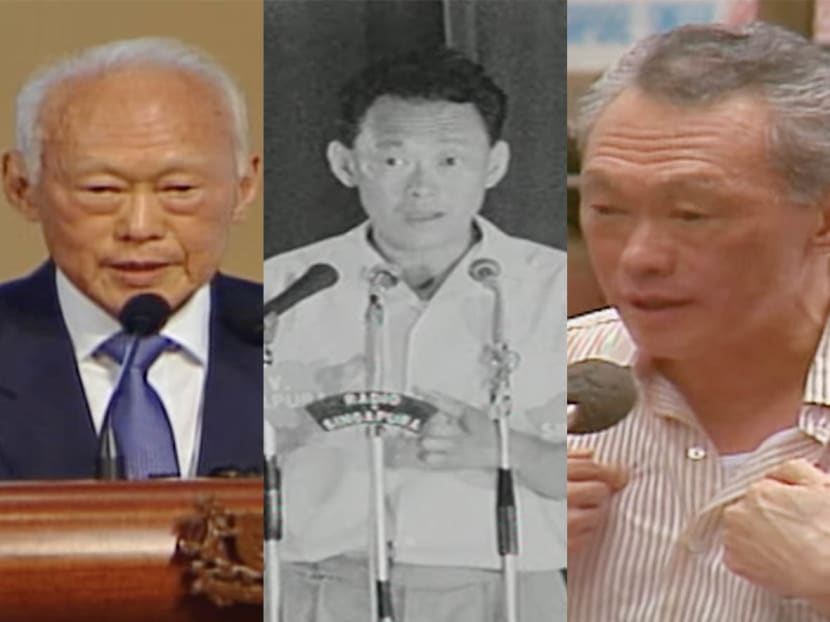Commentary: Understanding Lee Kuan Yew’s ‘moment of anguish’ on Aug 9, 1965
Singapore marks its 58th year of independence on Wednesday (Aug 9).

Singapore's founding prime minister Lee Kuan Yew delivering speeches at (L-R) his 80th birthday dinner in 2003, Liquor Retailers' Association anniversary celebrations in 1965 and 1980 General Elections.
Singapore marks its 58th year of independence on Wednesday (Aug 9).
It is timely to look back at a key moment in the country’s birth, specifically that of founding Prime Minister Lee Kuan Yew tearing up as he sought to explain at a press conference on the afternoon of Aug 9, 1965, Singapore’s separation from Malaysia.
The moment has been replayed and reproduced on television and other media many times over the years.
Both the current Primary 4 and Secondary 2 social studies textbooks feature photos of Mr Lee announcing the separation, with the secondary textbook describing him as “emotional”.
But what are the reasons for his tearing up?
Some Singaporeans may not have a clear and accurate understanding of the context of his anguish, believing that Mr Lee teared up because he might be shocked and upset about what the future held for Singapore and its citizens.
The analysis of primary sources such as memoirs and first-hand documents will enable us to have a better understanding of that moment and our history.
Mr Lee had initially believed in the merger that took place in 1963.
However, differences between Singapore and Malaysia on political and economic issues grew following the merger, in addition to the tensions leading to racial riots here in 1964.
During the press conference on Aug 9, 1965, as he teared up, Mr Lee said: “For me, it is a moment of anguish because all my life... you see, the whole of my adult life... I had believed in merger and the unity of these two territories. You know, it's a people, connected by geography, economics, and ties of kinship.”
While he was pained by the separation, it was not a sudden event that caught him by surprise.
He had been involved in the planning and preparation for independence since July 1965 when he asked Law Minister E W Barker to draft the separation documents.
As Mr Lee wrote in his memoirs published in 1998: “Eddie drafted two documents, but I asked him to draw up a third, a proclamation of independence.”
In January 1965, Mr Lee expressed in a previously confidential memorandum to the Cabinet that then Malaysian Prime Minister Tunku Abdul Rahman had informed Singapore’s then Finance Minister Goh Keng Swee in December 1964 “of his desire to have Singapore ‘hive off’ from Malaysia”.
This led to “considerable excitement” among the key leaders of Singapore, according to the same Cabinet memo.
Mr Lee shared his vision: “The picture of a prosperous and flourishing Singapore doing better than the rest of Malaysia is most attractive.”
With the support of Mr Lee, Dr Goh subsequently proposed a full separation to the Malaysian leaders. Both sides negotiated the terms and agreed on the separation.
After the strife and differences during the merger period, leaders from both sides realised that the best approach forward was to separate and still cooperate and collaborate.
As revealed by Mr Lee at that press conference, Tunku Abdul Rahman had the foresight and wisdom to state that “when you (Singapore) are no longer in Malaysia and we are no longer quarrelling either in Parliament or in the constituencies, we'll be friends again, and we'll need each other, and we'll co-operate".
This was a positive direction forward. Today, Singapore and Malaysia continue to be connected by ties of kinship, geography and economics.
If Mr Lee had a vision of “a prosperous and flourishing Singapore” that was “without interference from KL (Kuala Lumpur)" and our independence was a step in that direction, why then did he break down at the press conference?
Mr Lee clarified in his memoirs: “I had let down many people in Malaya, Sabah and Sarawak. They had responded to our call of a Malaysian Malaysia.”.
He elaborated: “By accepting separation, I had failed them. That sense of guilt made me break down. It was my moment of anguish. The deed was done, but I was overwrought at the thought of all the shattered hopes of the millions we had aroused.”
Mr Lee’s moment of anguish was linked to his empathetic thoughts that he had let down many supporters in Malaysia.
In a personal letter dated Aug 10, 1965 written to Mr Lee by then Sabah Chief Minister Fuad Stephens, the Chief Minister expressed his surprise and disappointment over the separation.
“Why? I have kept asking myself this since Sunday morning when I was told of the decision to carve up Malaysia,” he wrote.
“Tears, heartbreak and completely lost,” he added on how he felt.
Despite the disappointment, he ended his letter on a positive note: “I wish all will go well with you yet.”
Though it was a moment of anguish for Mr Lee and disappointment for some in August 1965, the separation led to the birth of an independent, thriving nation that has sought to build close and beneficial relations with its neighbours.
I would also add that we should not focus just on that moment of anguish by Mr Lee at the press conference.
Mr Lee’s highly important message to citizens can be found in his closing statements on that fateful day: “Be firm, be calm. We are going to have a multi-racial nation in Singapore. We will set the example... Everybody will have his place. Equal. Language, culture, religion.”
This should be a key message articulated in our textbooks too.
When examining historical incidents or issues, Singaporeans should go beyond a narrow focus and the initial representations or portrayals.
We should also examine the intentions, motivations and actions of the historical figures or people involved.
Mr Lee’s final words at the press conference were: “We unite, regardless of race, language, religion, culture."
Amidst our diversity and current challenges, this message of unity and calm determination to progress ahead remains pertinent in our nation’s journey.
ABOUT THE AUTHOR:
Edmund Lim is the vice-president of an education technology company. He has served as a district councillor, taught social studies at the National Institute of Education, Nanyang Technological University and wrote books on the first three presidents of Singapore.









